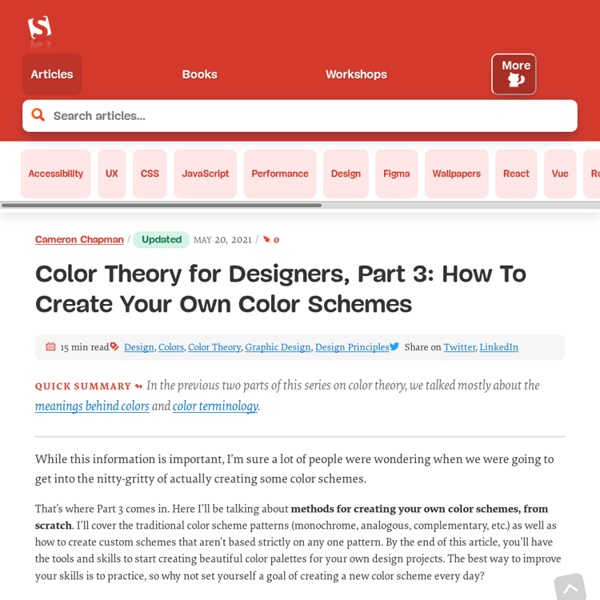Guide des couleurs d'un développeur Web
In this article, Laura Elizabeth shares a simple color workflow that you can use in your next web project. I’ve never been a fan of color theory. I think it’s because I’ve always been a bit hopeless at it. I’d love to be able to sit there, color wheel in hand, and pick out complementary, split-complementary and triad color schemes, impressing all of my friends, family and clients in the process. But the theory has always eluded me, and, truthfully, I’ve never found it useful when trying to use color in my projects. Somewhat ironically, I’ve been finding that the better I get at choosing and using color, the better I become in the theory behind it.
Color Theory For Designers, Part 2: Understanding Concepts And Color Terminology
About The Author Cameron Chapman is a professional Web and graphic designer with over 6 years of experience. She writes for a number of blogs and is the author of The Smashing … More about Cameron ↬ If you’re going to use color effectively in your designs, you’ll need to know a few color concepts, as well as color theory terminology. A thorough working knowledge of concepts like chroma, value, and saturation is key to creating your own awesome color palettes (which we’ll get to in Part 3). [Content update: August 2017]
Color Theory for Designers, Part 1: The Meaning of Color
About The Author Cameron Chapman is a professional Web and graphic designer with over 6 years of experience. She writes for a number of blogs and is the author of The Smashing … More about Cameron ↬
FlexBox Cheat Sheets in 2021
It's 2021! Let's refresh Our CSS Flexbox Memory. Here's a Cheat Sheet of everything you can do with CSS flexbox to get started in 2021. The Direction/Orientation in which flex-items are distributed inside flex-container.
Dark mode : astuces pour créer les meilleurs thèmes sombres du web
Dim the lights, relax your eyes and save your energy. Dark mode is one of the biggest trends in design, and world-class brands like WhatsApp, Instagram, Google, Facebook and Apple have already jumped on the dark mode design train. Let’s take a look at what these top brands are doing and how you can bring dark mode UI into your own designs. You’ll learn the pros and cons of dark mode and essential best practices when designing for dark mode to make sure your web and app designs look and function perfectly.
: How To Add Javascript To HTML
HTML5, CSS and JavaScript are the inseparable trinity of modern webpages. HTML lets us add content to the webpage, CSS helps with styling and layout, and JavaScript adds the interactivity in the page. We will learn briefly about the JavaScript and then how to link JavaScript to HTML.
Création de logo: tout ce que vous devez savoir
If your company needs a new logo design, you'll probably be exploring your options. Do you go for a completely different logo or tweak the logo design you already have? Either way, you might be questioning: what makes a great logo design? And how do you design a logo that captures the essence of a product, person or brand? We're here to answer all of your burning questions about logo design, just use the links below to jump to the section you're interested in. If you need some ideas along the way, check out our post on logo design inspiration, or the best 3-letter logos ever made.
5 Tips for Designing One-page Websites That Work
Looking for a fresh approach to designing websites? One-page websites can create more memorable and less overwhelming experiences for visitors…when designed the right way. Smart design choices can help reduce the fatigue and frustration people would otherwise feel when using the web.
Optimizing CSS for faster page loads - Tomas Pustelnik's personal website
Not long ago I decided to improve the loading times of my website. It already loads pretty fast, but I knew there was still room for improvement and one of them was CSS loading. I will walk you through the process and show you how you can improve your load times as well. Why loading time matters?



